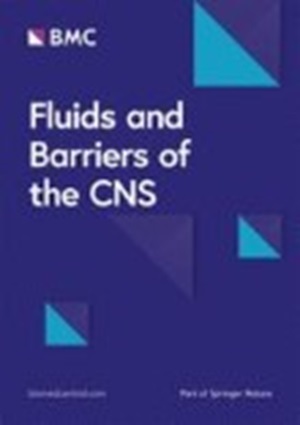[1-11C]-丁醇正电子发射断层扫描显示,在淀粉样蛋白阳性的老龄受试者中,大脑到鼻甲的通路受损
IF 5.9
1区 医学
Q1 NEUROSCIENCES
引用次数: 0
摘要
脑脊液(CSF)清除能力下降被认为是阿尔茨海默病(AD)的病理特征之一。非人类哺乳动物的大量文献和人类神经影像学数据相互矛盾,因此鼻粘膜是否是人类脑脊液的排泄部位仍是未知数。在这里,我们使用[1-11C]-丁醇(一种高渗透性放射性示踪剂,与大脑无明显结合)进行动态 PET,以验证鼻腔路径的示踪剂排泄反映大脑 CSF 排泄的假设。作为对这一假设的验证,我们研究了脑液和鼻液引流时间是否相关并受脑淀粉样蛋白的影响。我们使用[1-11C]-丁醇对 24 名认知正常的受试者(≥ 65 岁)进行了 60 分钟的动态 PET 成像。使用[11C]-PiB或[18F]-FBB进行成像,确定了8名淀粉样蛋白PET阳性(Aβ+)和16名Aβ-受试者。核磁共振成像确定的感兴趣区(ROI)包括:颈动脉、侧眶额叶(LOF)脑、楔形板以及由上、中、下鼻甲组成的全鼻甲区。双侧颞肌和颈静脉作为对照区域。区域时间活动被用来模拟示踪剂的流入、流出和 AUC。LOF 和全鼻甲 60 分钟 AUC 呈正相关,这表明大脑和鼻子之间存在联系。此外,Aβ+ 亚组显示出示踪剂动力学受损,表现为示踪剂流入减少和流出减慢。数据显示,大脑和鼻甲的示踪剂动力学相互关联,都反映了大脑的淀粉样蛋白状态。因此,这些数据增加了鼻腔通路是人类潜在 CSF 引流部位的证据。这些数据值得进一步研究大脑和鼻腔对神经退行性疾病蛋白质清除的贡献。本文章由计算机程序翻译,如有差异,请以英文原文为准。
[1-11C]-Butanol Positron Emission Tomography reveals an impaired brain to nasal turbinates pathway in aging amyloid positive subjects
Reduced clearance of cerebrospinal fluid (CSF) has been suggested as a pathological feature of Alzheimer’s disease (AD). With extensive documentation in non-human mammals and contradictory human neuroimaging data it remains unknown whether the nasal mucosa is a CSF drainage site in humans. Here, we used dynamic PET with [1-11C]-Butanol, a highly permeable radiotracer with no appreciable brain binding, to test the hypothesis that tracer drainage from the nasal pathway reflects CSF drainage from brain. As a test of the hypothesis, we examined whether brain and nasal fluid drainage times were correlated and affected by brain amyloid. 24 cognitively normal subjects (≥ 65 years) were dynamically PET imaged for 60 min. using [1-11C]-Butanol. Imaging with either [11C]-PiB or [18F]-FBB identified 8 amyloid PET positive (Aβ+) and 16 Aβ- subjects. MRI-determined regions of interest (ROI) included: the carotid artery, the lateral orbitofrontal (LOF) brain, the cribriform plate, and an All-turbinate region comprised of the superior, middle, and inferior turbinates. The bilateral temporalis muscle and jugular veins served as control regions. Regional time-activity were used to model tracer influx, egress, and AUC. LOF and All-turbinate 60 min AUC were positively associated, thus suggesting a connection between the brain and the nose. Further, the Aβ+ subgroup demonstrated impaired tracer kinetics, marked by reduced tracer influx and slower egress. The data show that tracer kinetics for brain and nasal turbinates are related to each other and both reflect the amyloid status of the brain. As such, these data add to evidence that the nasal pathway is a potential CSF drainage site in humans. These data warrant further investigation of brain and nasal contributions to protein clearance in neurodegenerative disease.
求助全文
通过发布文献求助,成功后即可免费获取论文全文。
去求助
来源期刊

Fluids and Barriers of the CNS
Neuroscience-Developmental Neuroscience
CiteScore
10.70
自引率
8.20%
发文量
94
审稿时长
14 weeks
期刊介绍:
"Fluids and Barriers of the CNS" is a scholarly open access journal that specializes in the intricate world of the central nervous system's fluids and barriers, which are pivotal for the health and well-being of the human body. This journal is a peer-reviewed platform that welcomes research manuscripts exploring the full spectrum of CNS fluids and barriers, with a particular focus on their roles in both health and disease.
At the heart of this journal's interest is the cerebrospinal fluid (CSF), a vital fluid that circulates within the brain and spinal cord, playing a multifaceted role in the normal functioning of the brain and in various neurological conditions. The journal delves into the composition, circulation, and absorption of CSF, as well as its relationship with the parenchymal interstitial fluid and the neurovascular unit at the blood-brain barrier (BBB).
 求助内容:
求助内容: 应助结果提醒方式:
应助结果提醒方式:


